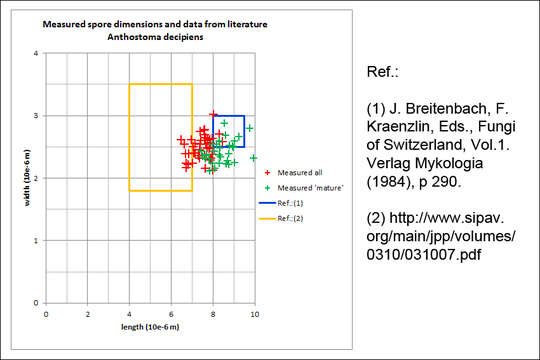Anthostoma-decipiens_spore_stat_2M

Description:
Anthostoma decipiens (de Cand. ex Fr.) Nke.DE: Geschnbelter KugelpilzSlo.: no nameDat.: March 6. 2011Lat.: 46.31774 Long.: 13.49219Code: Bot_491/2011_DSC6610Habitat: former pastures, now overgrown with bushes (Corylus avellana dominant) and scattered Picea abies and Fagus sylvatica, Ostrya carpinifolia and Fraxinus ornus; almost flat terrain; calcareous ground; half shade; relatively warm place; exposed to direct rain; average precipitations ~ 3.000 mm/year, average temperature 8-10 deg C, elevation 370 m (1.200 feet), alpine phytogeographical region.Substratum: rotten branch of Corylus avellana lying on ground, still in bark.Place: Bovec basin, between Bovec and village aga, right bank of river Soa and right bank of Boka stream, west of the left trail to Boka waterfall viewpoint, East Julian Alps, Posoje, Slovenia EC. Comments: Anthostoma decipiens really deserves it species name (decipiens = deceiving). When I found it I was sure I found Cryptospora corylina. Habitus, habitat and all macroscopic features described in Breitenbach (1984) (Ref.: 1) fit well to the observation. Also the picture of Cryptospora published there was like my own. But when I looked through the microscope spores were a real surprise. Instead to be very long (50 - 85 microns) and filiform they were short, cylindrical, allantoid 'sausages'. Many Diatrypaceae are macroscopically deceivingly similar. Microscopy revealed Anthostoma decipiens. Substrate is correct. Perithecia are of proper dimensions, of caespitose growth (growing in dense tufts) of 10 or more fruitbodies packed into a pale ochre-brown stoma protruding through the bark and ending with black furrowed perithecial ostioles. Asci are irregularly biseriate, with long apical ring. No paraphyses were seen, which fits to observation in Breitenbach (1984) (Ref.:1.). Spores fit somewhere in between widely different data from Ref.:1. and Ref.:2. Since spores were obtained from crashed perithecia, many of them were eventually not mature. Therefore a second measurement was done taking into account only larges spores (assumed to be mature). Also asci dimensions given in literature differ significantly. I know no explanation of these differences.Spores smooth, allantoid, cylindrical. Dimensions of the first measurement taking into account all spores. 6.5 [7.3 ; 7.6] 8.4 x 2.1 [2.4 ; 2.5] 2.9 microns; Q = 2.5 [2.9 ; 3.1] 3.5; N = 40; C = 95%; Me = 7.5 x 2.5 microns; Qe = 3. Second measurement taking into account only larges spores (assumed to be mature) gave following result: 7,1 [8,2 ; 8,7] 9,8 x 1,9 [2,3 ; 2,5] 3 microns; Q = 2,8 [3,4 ; 3,7] 4,3; N = 31; C = 95%; Me = 8,5 x 2,4 microns; Qe = 3,5. Asci dimensions: 46.3 [57.4 ; 65.9] 77.1 x 5.5 [6.1 ; 6.6] 7.2 microns; Q = 7.9 [9.2 ; 10.2] 11.5; N = 13; C = 95%; Me = 61.7 x 6.4 microns ; Qe = 9.7 (Ref.:1. gives 60-80 x 5.5-7.5 microns, Ref.: 2. gives 35-60/4-5 microns). Olympus CH20, NEA 100x/1.25, magnification 1.000 x, oil, in water, in vivo. AmScope MA500 digital camera.Ref.:(1) J. Breitenbach, F. Kraenzlin, Eds., Fungi of Switzerland, Vol.1. Verlag Mykologia (1984), p 290.(2) www.sipav.org/main/jpp/volumes/0310/031007.pdf (3) agris.fao.org/agris-search/search.do?recordID=US201500224751
Included On The Following Pages:
- Life (creatures)
- Cellular (cellular organisms)
- Eukaryota (eukaryotes)
- Opisthokonta (opisthokonts)
- Nucletmycea
- Fungi (mushrooms, lichens, molds, yeasts and relatives)
- Dikarya
- Ascomycota (sac fungi)
- Sordariomycetes
- Xylariales
- Diatrypaceae
- Anthostoma
- Anthostoma decipiens
This image is not featured in any collections.
Source Information
- license
- cc-by-nc-sa
- copyright
- Amadej Trnkoczy
- photographer
- Amadej Trnkoczy
- original
- original media file
- visit source
- partner site
- Flickr Group
- ID


